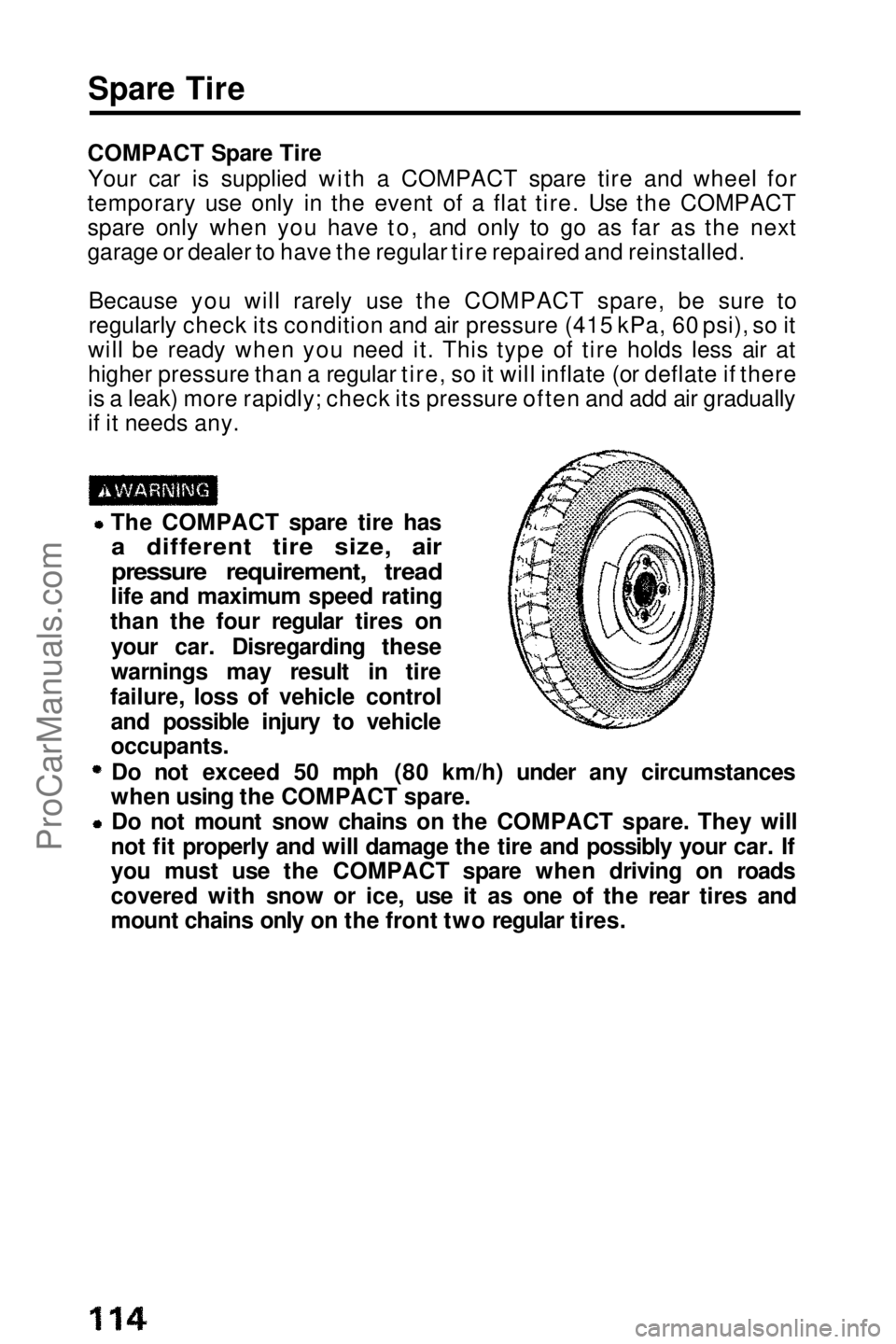1990 HONDA PRELUDE tire type
[x] Cancel search: tire typePage 72 of 143

Towing a Trailer (cont'd)
Hitches
Use only a hitch recommended by your Honda dealer. The hitch
should be bolted securely to the car and installed by a qualified
technician. Do not use a hitch designed for temporary installation
and never use one that attaches only to the bumper.
Trailer Brakes and safety chains
The Honda Automobile Division recommends that trailers equippedwith brakes, should conform to any applicable federal and stateregulations, When using a trailer equipped with electric brakes, a
trailer brake controller that connects to the car's electrical system is recommended. Installing a brake controller that connects to the car's
brake hydraulic system could result in brake fluid contamination or
leaks, A safety chain must always be used between the car and the
trailer. Leave sufficient slack in the chain so that it does not bind in
sharp turns. The chain should cross under the trailer tongue to prevent the tongue from dropping to the ground.
Tires
Make sure your car's are properly inflated. Adjust tire pressure
to the recommended tire pressure indicated on the label attached to
the edge of the driver's door.The trailer tires should be of the proper size, load rating and inflated to the pressure recommended
by the trailer manufacturer.
Trailer Lights
Trailer light must comply with federal, state and local regulations. See your local recreation vehicle dealer or rental agency for the
correct type of lighting and wiring for your trailer, Check for correct
operation of the turn signals and stop lights each time you hitch up.
CAUTION:
Connections to your car's electrical system should be made by
your Honda dealer or a qualified electrician.Improper installation
may damage your vehicle's electrical system and cause a
malfunction of the lights.
ProCarManuals.comMain Menu t s
Page 106 of 143

Tires (cont'd)
Tire Chains
When required, tire chains should be installed on the front wheels. If
you are using metal type chains, make sure they are designated SAEClass "S". You may also use plastic or cable type "chains". Use
only the correct size chains recommended for your tire size andmake sure they are installed following the chain manufacturer's
instructions.
Once tire chains are installed, drive at less than 19 mph (30km/h) on
roads covered with snow or ice. To minimize tire and chain wear,
avoid driving on cleared roads with chains installed.
CAUTION:
Improper installation or loose tire chains may damage your car's
chassis and fenders.
NOTE:
Keep the manufacturer's installation instructions in your glove box
for future reference.
Tire Balancing
Unbalanced tires may affect handling and tire wear. A tire should
always be rebalanced after it has been dismounted from the wheel.
Your original tires were properly balanced before the car left the
factory, but may need rebalancing at some time during the life of the
tire. Tire balancing for the COMPACT spare is not necessary.
CAUTION:
Use only genuine Honda aluminum wheel weights if your car is
equipped with aluminum wheels. Non-genuine Honda wheel
weights may corrode and damage the aluminum wheel.
Tire Rotation Tires may wear unevenly when used for a long time at the same position on the car. To avoid this, rotate the tires every 7,500 miles
(12,000 km). If abnormal or uneven wear develops between
rotations, the cause should be found and corrected as soon as
possible. The illustration shows how the tires can be rotated. The
COMPACT spare tire must not be included in tire rotation.ProCarManuals.comMain Menu t s
Page 111 of 143

Washing
NOTE:
Retract the headlights before washing the car. However, make sure
the headlight lenses are cleaned periodically.
Rinse all loose dirt off the car by spraying it with lukewarm or cold
water. Do not use hot water.
Wash using a soft bristle brush, sponge, or cloth with water
containing a mild detergent, such as a liquid dishwashing detergent.
Remove oil, tar, tree sap, etc., with tar remover or turpentine.
Remove road salt, insects, etc., with mild detergent and lukewarm
water. Any of these substances may damage the finish if left on
painted surfaces.
Rinse the car well. Promptly wipe with a chamois or soft towel toprevent water-spotting. Do not let water or soap air-dry on painted
surfaces.
During wiping, inspect the surface for stone chips and scratches;paint them with touch-up paint so they won't rust (touch-up paint
is available through your Honda dealer).
For further instructions on corrosion protection, refer to the Rust
Prevention section on page 112.
Aluminum Alloy Wheels (Si with 4WS or ALB)
CAUTION:
Wash the wheels after driving on snowy or icy roads where salt
has been applied.
Avoid off-road driving. Brush, rocks, dirt and severe impact may
damage the wheels.
Install tire chains carefully. Improperly installed chains can cause
damage to the wheels.
Honda aluminum alloy wheels are treated with a protective
finish. Wash them with a low-phosphate detergent and sponge.
Do not use abrasive cleaners or stiff brushes. Always install aluminum wheels in sets of four. If mixed with
other types, the car's handing may be affected.
(cont'd)ProCarManuals.comMain Menu t s
Page 114 of 143

Spare Tire
COMPACT Spare Tire Your car is supplied with a COMPACT spare tire and wheel for
temporary use only in the event of a flat tire. Use the COMPACT
spare only when you have to, and only to go as far as the next
garage or dealer to have the regular tire repaired and reinstalled.
Because you will rarely use the COMPACT spare, be sure to
regularly check its condition and air pressure (415 kPa, 60 psi), so it
will be ready when you need it. This type of tire holds less air at
higher pressure than a regular tire, so it will inflate (or deflate if there
is a leak) more rapidly; check its pressure often and add air gradually
if it needs any. The COMPACT spare tire has
a different tire size, air
pressure requirement, tread
life and maximum speed rating
than the four regular tires on
your car. Disregarding these
warnings may result in tire
failure, loss of vehicle control and possible injury to vehicle
occupants.
Do not exceed 50 mph (80 km/h) under any circumstances
when using the COMPACT spare. Do not mount snow chains on the COMPACT spare. They will
not fit properly and will damage the tire and possibly your car. If
you must use the COMPACT spare when driving on roads
covered with snow or ice, use it as one of the rear tires and
mount chains only on the front two regular tires.ProCarManuals.comMain Menu t s
Page 121 of 143

If towing is necessary, contact a professional towing service. Your
authorized Honda dealer can assist you with detailed towing
instructions.
Never use tow chains or rope to tow a car; your ability to safety
control the car may be adversely affected.
We recommend the following:
Flat Bed Equipment — Entire car is winched on a flat bed vehicle.
This is the best way of transporting your Honda.
Wheel Lift Type — Tow with the front wheels off the ground.
If the
car can only be towed with the front wheels on the ground:
make sure the transmission is full of fluid (see page 86 — 87)
and tow with the transmission in neutral (N) and the ignition key in
the I position.
CAUTION:
To avoid serious damage on automatic transmission cars, first start the engine and shift to D, then to N and shut the engine off. If
the engine does not run or the transmission cannot be shifted
while the engine is running, the car must be transported on flatbed equipment.
Check local regulations for towing.
CAUTION:
Do not exceed 35 mph (55 km/h) or tow for distances of more
than 50 miles (80 km). If a Sling Type tow is used, the tow truck driver should position
wood spacer blocks between your car's frame and the chains
and lift straps to avoid damaging the bumper and the body. Do not use the bumpers to lift the car or to support the car's
weight while towing.
When towing a car with 4WS even with the front wheels off the ground, turn the wheels straight ahead and tie the steering wheel in place. TowingProCarManuals.comMain Menu s t
Page 143 of 143

Gas Station Information
Gasoline: UNLEADED onlyPump octane of 86 or higher.
Gas Tank-Capacity: 60 l (15.9 US gal, 13.2 Imp gal)
Tire Pressure (measured cold): Front/ Rear 195 kPa (28 psi) 180 kPa (26 psi)
Si (with 4WS) 195 kPa (28 psi) 195 kPa (28 psi)
Compact Spare Tire 415 kPa (60 psi)
Other Tire Information: Label on driver's door edge.
Hood Release: Pull handle under left side of dash.
Engine Oil: An "Energy Conserving II" SG grade oil is recommended. See page 83 for viscosity
recommendations.
Capacity (including filter):
3.8 l ( 4.0 US qt, 3.3 Imp qt)
Manual Transmission Oil: Recommended type—SAE 10W—30 or10W—40 weight, grade SE or SF.
Capacity (including differential):
2.1 l (2.2 US qt, 1.8 Imp qt)
Automatic Transmission Fluid:
Use DEXRON® II type Automatic Transmission Fluid
(ATF). Unscrew dipstick in right end of transmission,
wipe off, reinsert, remove and read fluid level-do not screw-in to check fluid level.
Capacity (Including differential):
2.8 l (3.0 US qt, 2.5 Imp qt)
Power Steering Fluid: Use only Honda power steering fluid: do not use ATF
or any other brand of power steering fluid because it
will damage the system.
AMERICAN HONDA MOTOR CO., INC.
1919 Torrance Blvd., Torrance, California 90501
1990 Honda Motor Co., Ltd. — All Rights Reserved
31SF1621
00X31-SF1-6211CRESTEC5009806 L PRINTED IN U.S.A.
ProCarManuals.comMain Menu t s